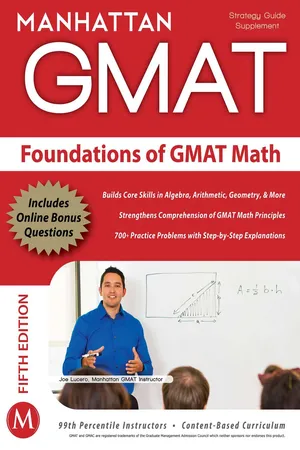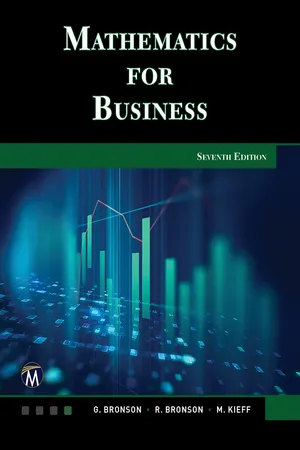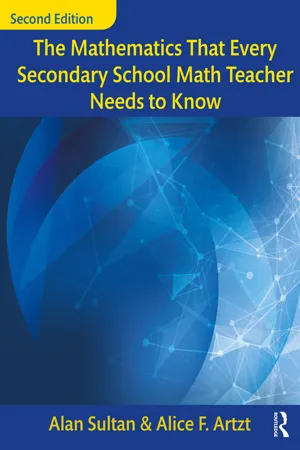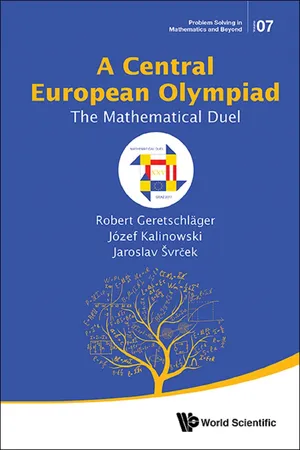Mathematics
Quadratic Equations
Quadratic equations are second-degree polynomial equations that can be expressed in the form ax^2 + bx + c = 0, where a, b, and c are constants and x represents the variable. These equations often have two solutions, known as roots, which can be found using the quadratic formula or by factoring. Quadratic equations are widely used in various fields, including physics, engineering, and economics.
Written by Perlego with AI-assistance
Related key terms
Related key terms
1 of 4
Related key terms
1 of 3
7 Key excerpts on "Quadratic Equations"
- eBook - ePub
- Manhattan GMAT(Author)
- 2011(Publication Date)
- Manhattan Prep Publishing(Publisher)
Chapter 7: Quadratic EquationsIn This Chapter:• Manipulating quadratic expressions and solving Quadratic Equations Mechanics of Quadratic Equations In high school algebra, you learned a number of skills for dealing with Quadratic Equations. For the GMAT, you need to relearn those skills.Let's define terms first. A quadratic expression contains a squared variable, such as x2 , and no higher power. The word “quadratic” comes from the Latin word for “square.” Here are a few quadratic expressions:
A quadratic expression can also be disguised. You might not see the squared exponent on the variable explicitly. Here are some disguised quadratic expressions.z2 y2 + y – 6 x2 + 8x + 16 w2 – 9 z × z (y + 3)(y – 2) (x + 4)2 (w – 3)(w + 3) If you multiply these expressions out—that is, if you distribute them—then you see the exponents on the variables. Note that the second list corresponds to the first list exactly.A quadratic equation contains a quadratic expression and an equals sign.Quadratic expression = something elseA quadratic equation usually has two solutions. That is, in most cases, two different values of the variable each make the equation true. Solving a quadratic equation means finding those values.Before you can solve Quadratic Equations, you have to be able to distribute and factor quadratic expressions.Distribute (a + b)(x + y) Use FOILRecall that distributing means applying multiplication across a sum.
You can omit the multiplication sign next to parentheses. Also, the order of the product doesn't matter, and subtraction works the same way as addition. Here are more examples:= 5 × 3 + 5 × 4 equals five times three plus five times four. - eBook - ePub
- Gary Bronson, Richard Bronson, Maureen Kieff(Authors)
- 2021(Publication Date)
- Mercury Learning and Information(Publisher)
quadratic functions , and have the form:f (x ) = a 2 x 2 + a 1 x + a 0where a 2 ≠ 0. If we replace the constants a 2 , a 1 , and a 0 , by a , b , and c , respectively, this second-degree polynomial function is written in its more conventional form as:y = ax 2 bx + c (Eq. 3.8)In Equation 3.8, the variable that is squared is referred to as the quadratic variable , which in this case is x . Note that what determines if an equation is a function are not the symbols used in the equation, but whether the equation, domain, and range satisfy the definition of a function provided in Section 3.1 .Example 1 Determine which of the following functions are quadratic functions. For those that are, state their coefficients, a, b, and c.a. y = 2x 2 − ½b. y = 3x − x 2c. n 2 = 2p + 4Solutiona. This is a quadratic function in the variable x with a = 2, b = 0, and c = − 1/2.b. Rewriting this equation as y = − x 2 + 3x , we see that this is a quadratic function in the variable x with a = − 1, b = 3, and c = 0.c. Rewriting this equation as f (p ) = 1/2 n 2 − 2, we see that it is a quadratic function in the variable n , with a = ½, b = 0, and c = − 2.As in the case of linear equations and in part (c) of this example, the letters y and x - Alan Sultan, Alice F. Artzt(Authors)
- 2017(Publication Date)
- Routledge(Publisher)
ac . Observe that the left side is a perfect square. Take it from there.- 2 (C) For the quadratic equation ax 2 + bx + c = 0, where a, b , and c are integers, the quantity b 2 − 4ac is called the discriminant. In secondary school the following rule is taught: If the discriminant is 0, there is only one root of the quadratic equation ax 2 + bx + c = 0. If the discriminant is positive and a perfect square, then the two roots are real and rational and unequal. If the discriminant is positive and not a perfect square, the roots of the quadratic equation are irrational and unequal, and if the discriminant is negative, the roots are imaginary. Describe how you would justify these rules to your students. What would you tell them if they asked whether the rules were still true if b is irrational?
- 3 Solve the following Quadratic Equations by completing the square.
- (a) x 2 − 6x = −8
- (b) y 2 − 7y + 6 = 0
- (c) z (z − 1) + 1 = 0
- (d) 3z 2 − 2z + 1 = 0
- 4 In Figure 3.4 , we have a square and two rectangles.
Figure 3.4- (a) Find the area of the entire figure.
- (b) There is a small square missing that we can add in the lower right hand corner of the figure to make the entire figure a square. What is its area?
- (c) How does this figure relate to the idea of “completing the square?”
5 (C) One of your students was asked to solve x 2 − 8x- eBook - ePub
Differentiating Instruction in Algebra 1
Ready-to-Use Activities for All Students (Grades 7-10)
- Kelli Jurek(Author)
- 2021(Publication Date)
- Routledge(Publisher)
Unit 4QuadRatic Functions DOI: 10.4324/9781003234180-5The final unit focuses on quadratic functions. Students will continue their study of nonlinear functions by identifying quadratic functions in tables, graphs, and equations and identifying the characteristics of quadratics. Real-life applications introduced through story problems are included in most lessons. The final project, which could be used as an authentic assessment, is a catapult project.This unit begins with a pretest and four real-life applications of quadratic functions that can be discussed in small groups and then as a larger group. Many of the activities will offer the students an opportunity to choose learning activities according to their learning style, personal interests, and readiness level.What Do We Want Students to Know?
Common Core State Standards Addressed:• A.SSE.3a, 3b• AAPR.3• A.CED.2• A.REI.4a, 4b• F.IF.4, 6, 7a, 8a, 9• F.BF.1 Big Ideas• Quadratics are parabolas and must have a 2 as their highest exponent.• The zeros/solutions are where the parabola crosses the x-axis.• There are different ways to solve quadratics.• Different forms of quadratics provide different key information.• Quadratics can model many real-world situations. Essential Questions• What does it mean to find the zeros/solutions?• What is a parabola?• How do I determine the best method to solve a quadratic?• What information do I need to sketch a quadratic? Critical Vocabulary
Parabola Function x-intercept y-intercept Zeros(roots) Axis of symmetry Maximum value Minimum value Vertex Quadratic function Quadratic formula First differences Second differences Terms Unit Objectives
- eBook - ePub
- P.M. Cohn(Author)
- 2017(Publication Date)
- Chapman and Hall/CRC(Publisher)
9 Applications I. Algebra and geometry In this chapter and the next we give some illustrations of how the methods developed in Chapter 1, Chapter 8 can be applied. In most cases we merely sketch the outlines, to whet the reader’s appetite, with a reference to more thorough treatments. 9.1 QUADRICS IN SPACE A quadric surface or simply quadric is a surface in 3-space given by an equation of the second degree in the coordinates. It will be convenient to express all vectors in terms of coordinates referred to a right-handed rectangular coordinate system in space. Instead of speaking of ‘the vector whose components are a 1, a 2, a 3 ’ we shall simply speak of ‘the vector (a 1, a 2, a 3)’, leaving the coordinate system to be understood. As before, we shall abbreviate the coordinates by a single letter, for example, to say that u is a unit vector is to say that its components u 1, u 2, u 3 satisfy u 1 2 + u 2 2 + u 3 2 = 1, or, in matrix notation, u T u = 1, where u T = (u 1, u 2, u 3) and u is the corresponding column. The most general equation of the second degree (in 3-space). is a 11 x 1 2 + a 22 x 2 2 + a 33 x 3 2 + 2 a 12 x 1 x 2 + 2 a 13 x 1 x 3 + 2 a 23 x 2 x 3 + 2 a 1 x 1 + 2 a 2 x 2 + 2 a 3 x 3 + α = 0 where a 11,…, a 3, α are real numbers. In matrix form this equation can be written as x T A x + 2 a T x + α = 0 (9.1) where A = (a ij) is a symmetric matrix and a T = (a 1, a 2, a 3). A complete description of quadrics would take us too far afield, so we shall limit ourselves to the case where the matrix A is regular. In that case the quadric (9.1) is called central, because such a quadric has a centre of symmetry. This centre may be determined as follows. If we make a parallel translation of our coordinate system by a vector b, then the point with position vector x is described by a vector y, related to x by the equation x = y + b Expressed in the new system, equation (9.1) becomes y T A y + y T A b + b T A y + 2 a T y + β = 0 where β = b T Ab + 2 a T b + α - eBook - ePub
Making Sense of Mathematics for Teaching High School
Understanding How to Use Functions
- Edward C. Nolan, Juli K. Dixon, Farhsid Safi, Erhan Selcuk Haciomeroglu(Authors)
- 2016(Publication Date)
- Solution Tree Press(Publisher)
x = 3.One advantage of using the standard form of a line is that any line in the Cartesian coordinate plane—including vertical lines—can be described by this form. Through exploration, students come to see the benefits of certain forms of equations of a line over others. At times, the format is determined by the givens in the problem, and at other times, the format is driven by the goals of the problem. The same is true for Quadratic Equations.Exploring Different Forms of Quadratic FunctionsBy definition, a quadratic function is a function that can be described as f(x) = ax2 + bx + c, where a, b, and c are real numbers and a is not equal to zero. This form of the quadratic function is commonly referred to as the standard form. It is helpful for students to explore the constraint on the value of a being nonzero to determine the form of a quadratic function if the value of a is zero. As you may have realized, the function will be a linear function if the value of the parameter a in the standard form of a quadratic function is zero.Students explore quadratic functions in several forms. Why is this useful? Consider the task provided in figure 2.10 explore additional forms of the quadratic function.Figure 2.10: Model using different forms of a quadratic function task.While both functions model the path of the water in this fountain, which mathematical form is more suitable to answer the questions posed in this task? Which function, f(x) = −(x − 5)2 + 25 or f(x) = −x2 + 10x, allows you to more efficiently identify the vertex based on its structure? From the graph, you see that the maximum value occurs at (5, 25). In examining the two different representations of the quadratic function given in the task, you see that 5 and 25 both appear in the first equation. In this task, the value (5, 25) can be identified as the vertex (h, k) yielding the highest point on this curve. This equation is the vertex form of the quadratic equation, represented by y = a(x − h)2 + k. The values for h and k identify the vertex, but why? It is helpful to provide students opportunities to see that this form of the quadratic function always identifies the extreme value—maximum or minimum—of a quadratic function. This can be accomplished by engaging students in Mathematical Practice 8, “Look for and express regularity in repeated reasoning,” by providing several graphs of functions along with the vertex form of the equation for students to examine. Once students are able to conjecture that the vertex is identified within the vertex form by (h, k), they can be supported to engage in Mathematical Practice 7, “Look for and make use of structure,” to determine why this is the case. If given the opportunity, they can see that (x − h)2 cannot be negative and the minimum value for (x − h)2 occurs when x − h = 0. That minimum value describes the turning point of the graph, and at that minimum value, k describes the value for y because when x − h = 0, the function becomes y = k. An interesting question to ask students is how this minimum value can also describe the maximum point of the function, as with the case in the task in figure 2.10 . Students come to see the importance of the value of the parameter a - eBook - ePub
A Central European Olympiad
The Mathematical Duel
- Robert Geretschläger, Józef Kalinowski;Jaroslav Švrček(Authors)
- 2017(Publication Date)
- WSPC(Publisher)
Chapter 3Algebra3.1.Algebraic Equations
When students start to participate in mathematical competitions, many of them expect to encounter problems similar to those they are used to in standard school-book style, just a bit harder. In this situation, solving equations is certainly an expected type of activity. Of course, each equation they encounter at competition level introduces some newtwist, and their problem solving creativity is put to the test again and again.PROBLEMS
62. Determine all pairs (a, b) of real numbers such that the roots of the cubic equationare the numbers −a, −b and −ab.63. Let a ≠ 0, b, c be real numbers with |a + c| < |a − c|. Prove that the quadratic equation ax2 + bx + c = 0 has two real roots, one of which is positive and one of which is negative.64. Let a be an arbitrary real number. Prove that real numbers b and c certainly exist, such that65. Determine all cubic polynomials P(x) with real coefficients such that the equation P(x) = 0 has three real roots (not necessarily different) fulfilling the following conditions:(a) The number 1 is a root of the considered equation. (b) For each root t of the equation P(x) = 0 the condition P(2t) = t holds. 66. Determine all triples of mutually distinct real numbers a, b, c such that the cubic equationwith unknown x has three real roots a, b, c.67. We are given two real numbers x and y (x ≠ y) such that x4 +5x3 = y and y3 +5x2 = 1 hold. Prove that the equality x3 +x2 y+xy2 = −1 holds.68. Suppose the quadratic equationx2 − 2007x + b = 0with a real parameter b has two positive integer roots. Determine the maximum value of b.69. Determine all real solutions (x, y) of the equationSOLUTIONS
Problem 62. (A-I-1-15) Determine all pairs (a, b) of real numbers such that the roots of the cubic equationare the numbers −a, −b and −ab.Solution: Let us suppose that there exist real numbers a, b
Index pages curate the most relevant extracts from our library of academic textbooks. They’ve been created using an in-house natural language model (NLM), each adding context and meaning to key research topics.
Explore more topic indexes
Explore more topic indexes
1 of 6
Explore more topic indexes
1 of 4






